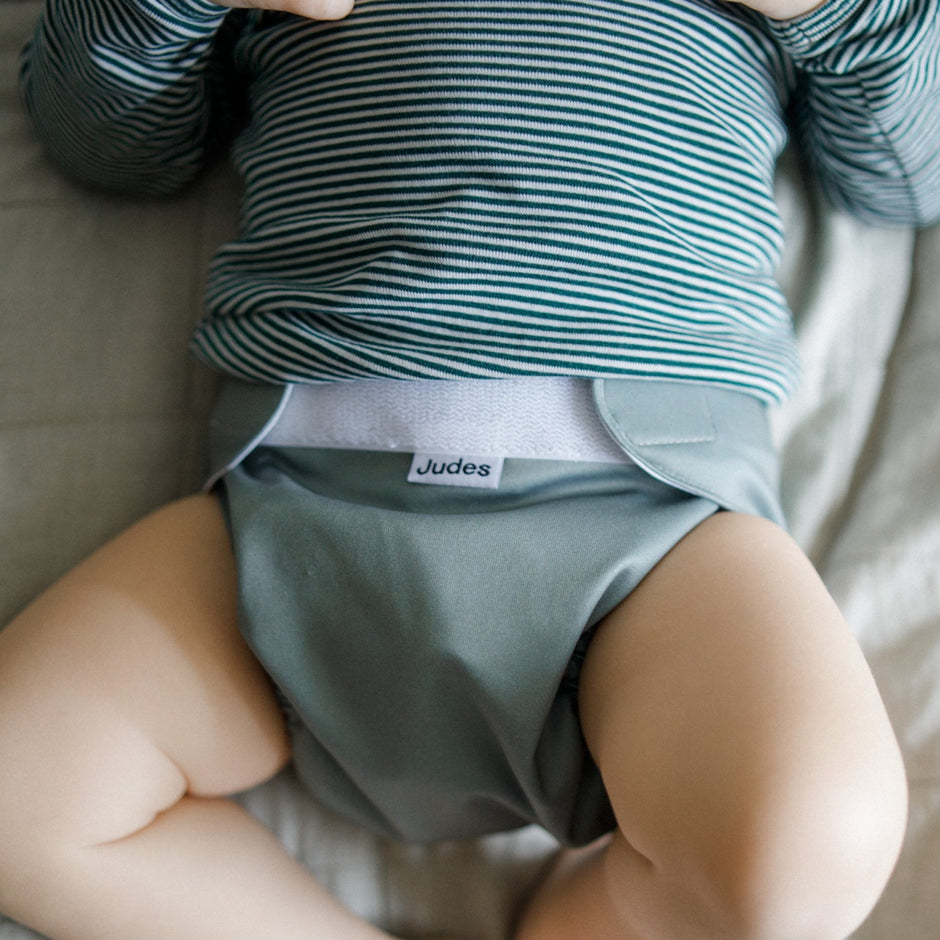Diaper Changes: How Often Should I Change My Baby's Diaper?
Updated on:
Photo by @isabelplett
With the birth of your first baby, new questions arise every day. Even if you perhaps didn’t expect it before, diaper changing has probably become a big topic for you too. This article should answer many of your questions about changing diapers.
How often do I need to change my baby's diaper?
|
Age |
How often to change the diaper? |
Diapers per day |
|
0 – 48 hours |
every 4 – 6 hours |
6 – 8 |
|
Newborn |
every 2 – 3 hours |
10 – 12 |
|
Infant |
every 3 – 4 hours |
8 – 10 |
|
From 6 months – toddler age |
during the day every 3 – 4 hours + 1 night diaper (approx. 12 hours) |
5 |
You should always change the diaper immediately after a bowel movement.
In addition to all the facts about changing diapers, I’ll explain below how you can tell if your infant is excreting enough and what healthy bowel movements in infants should look like.
How often should you change your baby's diaper?
The older your child gets, the longer the intervals between diaper changes become. As a rule of thumb, if there is a bowel movement, the diaper should be changed as soon as possible.
In the first 48 hours you usually only need to change your newborn’s diaper every four to six hours. After that, it’s about every two to three hours.
Newborn babies should be changed every two to three hours.
Infants aged two to six months generally need a fresh diaper every three to four hours.
From six months to toddler age it’s also sufficient to change your child’s diaper every three to four hours. From this age, your child usually only needs one diaper at night, as much less urine is produced at night than during the day.
It’s important to regularly change your baby’s diaper. This prevents diaper rash and ensures your baby feels comfortable.
Pay attention to your baby's signals and change the diaper more frequently if needed. Watch for signs that your baby is uncomfortable or producing more waste than usual.
If your baby has a sore bottom, you should also change the diaper more often. For rashes and irritation, fresh air is very good for your baby’s skin, so let your little one kick around without a diaper as often as possible.

Photo by @cafema.illustration
Signs that your baby needs a diaper change
There are several signs that can help you determine when it's time to change your baby's diaper. These include:
- Your baby is restless or crying
- Your baby's diaper is wet and heavy
- Your baby's diaper smells of stool or strongly of urine
- Your baby makes certain sounds or words before they need to go
- Gestures and facial expressions from your baby, such as making eye contact, fussing, stretching, or pushing
Over time, you'll learn to recognize your baby's signs. Many babies tend to go at certain times—for example, always in the morning. So you'll quickly learn how often a diaper change is needed at your home each day. This is also a good time to practice elimination communication.
How often should you change the diaper at night?
The answer to how often you should change your baby's diaper at night depends on several factors. The digestive system of newborns is not yet fully developed and they usually have a bowel movement after each feeding. Therefore, you need to change your newborn's diaper more frequently at night to avoid unnecessary irritation to their skin. Between the third and sixth month of life the digestive system usually matures and nighttime bowel movements become a thing of the past.
For urine, it depends on the absorbency of the diaper and your child's sensitivity. If your baby becomes restless in wet diapers and has difficulty falling back asleep, you should change them a bit more often at night.
Tips for nighttime diaper changes
- Good preparation → In the evening, prepare everything you’ll need for changing the diaper
- Create a relaxed environment
- Dim lighting → e.g., yellow light from a nightlight
- Calm surroundings → speak as little as possible, skin contact and minimal movement are much more important
- Warm environment → keep your hands warm; perhaps use a mobile heat lamp; you can also place the diapers on a radiator to gently warm them
- Suitable clothing and sleeping bag for easy diaper changes
- Suitable disposable diapers/cloth diapers for nighttime
- No pull-up diapers → This way, not everything has to be taken off completely
- Suitable cloth diapers for night
- Fitted diapers with cover
- All-In-Two diapers
- Judes cloth diapers
- Insert with wool cover
Do older children still need to be changed at night?
The older your child gets, the more likely it is that you can stop changing diapers at night.
On the one hand, the bladder of growing toddlers has a larger capacity, and on the other hand, the antidiuretic hormone (ADH) ensures that the body produces less urine at night. Your child's sleep is disturbed less often by the urge to urinate, and the amount of urine can be easily absorbed by the diaper. Often, the diaper will even stay dry until morning.
However, this is less clear with disposable diapers. Our study on potty training showed that more than 15 percent of children who use disposable diapers are changed for four years and longer. When cloth diapers are used, it’s less than one percent of children.

Photo by @ablondegirlsjourney
Change the diaper before or after breastfeeding?
Many newborns have a bowel movement during or after breastfeeding. If this is the case for your baby, you should change the diaper after breastfeeding. However, if your baby often spits up after feeding, you should wait a bit before changing or make sure not to put too much pressure on the tummy.
If your baby tends to fall asleep during or after breastfeeding without a bowel movement, then it's better to change the diaper before breastfeeding and then only change it again when your baby wakes up.
If your baby gets impatient as soon as they feel hungry and does not want to be changed before feeding, try to notice the first signs of hunger and change the diaper before your baby gets too hungry.
Do I need to change cloth diapers more often than disposable diapers?
No, you do not need to change cloth diapers more often than disposable diapers. Even though disposable diapers often promise twelve hours of dryness, you should still change them regularly. They are not very breathable, and due to the lack of airflow in the diaper area, your baby's skin is more susceptible to fungi, rashes, and diaper dermatitis.
Many people think that cloth diapers do not hold moisture as well as disposables. But that's not true at all. Cloth diapers are often even more leakproof than disposables. In addition, cloth diapers are more sustainable, healthier, and even cheaper than disposables.
Judes' goal is to be the simplest cloth diaper in the world. We believe Judes Family has done a fantastic job with this. Our Judes cloth diaper is just as easy to use as a disposable diaper and is ideal as a night diaper. The absorbent inner diaper quickly and securely absorbs all liquids, while the waterproof cover provides optimal protection. The breathable material ensures a healthy diaper environment.

Photo by @soapbubbbbles
How many wet diapers do babies have per day?
Your baby's output is an important indicator of their health. Especially for breastfed babies, you can use it to tell if they are getting enough to drink.
A newborn usually has only one to two wet diapers in the first 48 hours. After your milk comes in—usually after two to six days—your child should, according to Healthline, have at least five to six full diapers per day.
How do I know if the diaper is full?
For a diaper to be considered wet or full, it doesn't have to be on the verge of leaking.
A diaper is actually considered wet at around six tablespoons of liquid. This rule applies only to fully breastfed children, meaning your baby is getting no other liquids except breast milk at this time.
To get a sense of how much six tablespoons is, you can weigh a dry diaper, then fill it with water and weigh it again. This way you'll know at the same time what a full diaper looks and feels like and, if in doubt, you can simply check by weighing.
How can I tell if my baby is getting enough milk?
Besides wet diapers, there are of course other factors that can help you determine if your baby is getting enough nourishment.
Your child's weight gain and growth are important indicators of healthy development. The birth clinic, midwife, and pediatrician regularly monitor your child’s weight gain. There is no need for you to weigh your child between appointments.
Also, your baby's appearance offers clues for sufficient nutrition:
- Rosy skin tone
- Good skin tension
- Active and attentive behavior
In addition to these factors, you can also pay attention to your baby's behavior. A healthy baby will instinctively show you when they are hungry. Try to look out for their hunger cues and breastfeed your baby on demand.
A rough guideline: Most breastfed babies nurse 8 to 12 times in 24 hours during the first weeks.
Bowel movements – appearance, etc., what is normal
The first stool – meconium – is blackish to dark green and an important sign of a healthy digestive tract.
Normally, the newborn excretes the so-called meconium 12 to 48 hours after birth. By the fourth day at the latest, the meconium should be in the diaper.
What does the stool of breastfed babies look like?
The breast milk stool changes during this time, and both color and consistency can range from ochre, yellowish, or mustard brown to liquid, soft, or yogurt-like—all of these types of stools are completely normal. The smell varies from aromatic to slightly sour. Some even find the smell yeasty or even fruity.
What does the stool of formula-fed babies look like?
The stool of formula-fed babies is more pasty than that of breastfed babies. Sometimes, it may already be formed. The color of the stool ranges from light yellow to dark green—the range of colors is broad. The smell is often stronger compared to that of breastfed babies.
Did our article answer all your questions? If you have more questions, feel free to let us know in the comments! For all information about our cloth diapers, follow us on Instagram and connect in the comments with other Judes users.

